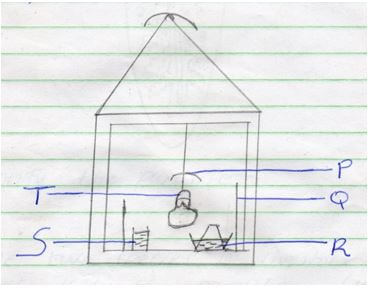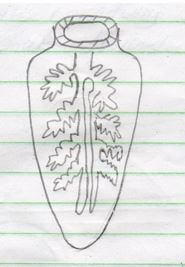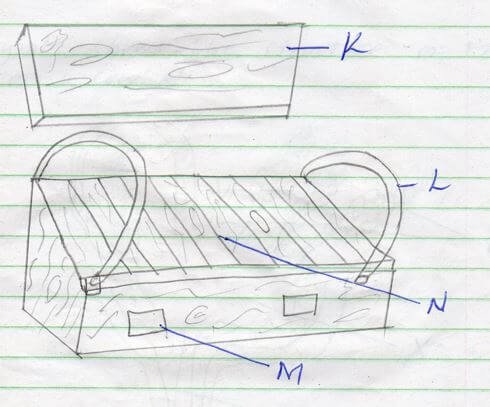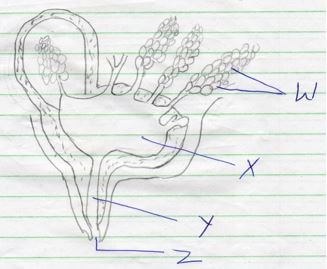QUESTIONS
SECTION A
Answer all the questions in the space provided
- State four advantages of using artificial incubation when hatching chicks 2mk)
- State four reasons why livestock should be weighed at weaning stage. 2mk)
- Outline four factors that affect the digestibility of a feed 2mk)
-
- Give three practices that can be carried out on wooden fences to make them durable. 1 ½)
- Outline three disadvantages of using hedges on the farm. 1 ½)
- List four safety precautions which should be considered when using farm tools 2mk)
- Outline four factors that lower the quality of concrete. 2mk)
- State four factors that would accelerate depreciation of farm machinery. 2mk)
- Give four products of microbial digestion in the rumen of cattle 2mk)
- State four factors a farmer should consider when selecting gilt for breeding. 2mk)
- Name the breeding system involved in each of the following cases.
- A Friesian sire from Kenya mated with a Friesian dam from Holland. 1mk)
- A Zebu sire (father) mated with a Zebu daughter. 1mk)
- Give the functions of the following hormones in livestock.
- Oxytocin 1mk)
- Stilbesterol 1mk)
- State four advantages of a spray race over a plunge dip. 2mk)
- The dressed weight of a beef animal is 450kg and its kill out percentage is 75. Calculate its live weight. 2mk)
- Give the meaning of the following terms as used in livestock management. 11/2mk)
- Bullock
- Pullet
- Sow
- State three reasons why steaming up is done in dairy cattle. 1 1/2mk)
SECTION B
Answer all the questions in the space provided.
- The diagram below shows a cross section of brooder. Use it to answer the questions that follows

- Identify the parts labeled P,Q , R, S and T. 2MK)
- What is the purpose of the part labeled Q . 1mk)
- State two ways by which temperature in the brooder may be raised. 1mk)
- Name any material that would be suitable for use as litter in the brooder. (1/2 mk)
- The diagram below shows a livestock parasite.

- Identify the parasite 1mk)
- Name the species of livestock commonly attacked by the parasite. 1mk)
- In which organ in the parasite found. 1mk)
- Give four symptoms of attack in livestock by the above parasite. 2mk)
- The diagram below shows a Kenya top bar hive. Study it carefully and answer the questions that follow.

- Identify the parts labelled L and M.1mk)
- State the functions of the parts labelled K, L and N 1 ½mk)
- Name the tool used to detach honey combs from the hive during honey harvesting. 1/2mk)
- State two maintenance practices carried out on the hive. 1mk)
- How can Bees be made to colonize a new hive? 1mk)
- The diagram shows the structure of the udder of a cow.

- Name the parts labelled W, X, Y and Z. 2MK)
- What is milk let down. 1mk)
- Name two hormones that control milk let down in a dairy cow. 1mk)
- What is dry cow therapy? 1mk)
SECTION C
Answer all the questions in the space provided.
-
- Described the use of the various tools required in the construction of a rabbit hutch. 10mk)
- Describe the advantages of battery cage system of rearing layers. 10mk)
-
- Outline the methods used to control internal parasites in livestock. 7mk)
- Discuss contagious abortion (brucellosis) under the following sub headings
- Animal species attacked. 2mk)
- Mode of trans mission 3mk)
- Symptoms 4mk)
- Control measures. 4mk)
-
- Explain the process of egg formation in the reproductive system of poultry. 10 mk)
- describe the maintenance practices carried out on a tractor before it is put to daily use. 10mk)
MARKING SCHEME
- State four advantages of using artificial incubation when hatching chicks 2mk)
- It has a high degree of hatchability.
- A farmer can plan when to incubate & hath chicks
- The incubator can be used throughout the year
- A large number of eggs can be hatched at the same time.
- The chicks are free from parasite & diseases infestation.
- State four reasons why livestock should be weighed at weaning stage. 2mk)
- To determine the amount of food to give to the livestock
- To determine the dosage / quantity of drugs to give to the livestock
- To determine their growth rate
- For selection / culling purposes
- For proper record – keeping purpose
- Outline four factors that affect the digestibility of a feed 2mk)
- Chemical composition of the feed
- Form in which the food is given to the animal
- Species of the animal
- The ratio of energy / carbohydrates to the proteins
- Feed mixtures & other ingredients in the feed
- Quantity of food already present in the digestive system.
-
- Give three practices that can be carried out on wooden fences to make them durable. 1 ½)
- Application of wood preservatives such as creosote
- Charring the posts
- Cutting the top at a slope
- Covering the top of the post with metal or plastic
- Reinforcing of the posts with concrete
- Outline three disadvantages of using hedges on the farm. 1 ½)
- They cause shading effects to crops
- They compete for growth factors with the crops
- They may harbour and transmit pests and transmit pests/vermin & diseases
- They require constant trimming, hence extra labour force
- Their roots may cause cracking of floors, foundations and walls of farm structures
- Give three practices that can be carried out on wooden fences to make them durable. 1 ½)
- List four safety precautions which should be considered when using farm tools 2mk)
- Tools should be used to perform the work they were designed for
- Tools should be maintained in good working conditions
- The user should be know how each tool is handled or used
- The user should wear the right protective clothing for the job
- The tools should be stored in safe places such as in tool racks or tool boxes.
- Outline four factors that lower the quality of concrete. 2mk)
- Impurities / foreign material
- Inappropriate mixing ratio / wrong ratio
- Quick drying / premature drying
- Poor mixing
- Large sizes of individual aggregate
- State four factors that would accelerate depreciation of farm machinery. 2mk)
- Wear and tear/ use
- Lack of maintenance
- Age of the equipment
- Obsolescence’s / change in technology
- Give four products of microbial digestion in the rumen of cattle 2mk)
- Volatile fatty acids
- Microbial proteins
- Ammonia
- Vitamin B complex and vitamin k
- State four factors a farmer should consider when selecting gilt for breeding. 2mk)
- Appropriate age of maturity and weight ie 6-12 months or 90-100kg live weight
- Good mothering ability
- Fast growth rate and early maturing
- Should be healthy
- Should be prolific
- Able to withstand the stresses of heat & services
- Good conformation. It should have along and deep body conformation/ well developed hams / legs well set apart / well arched topline.
- Name the breeding system involved in each of the following cases.
- A Friesian sire from Kenya mated with a Friesian dam from Holland. 1mk)
- Out breeding or out crossing
- A Zebu sire (father) mated with a Zebu daughter. 1mk)
- Inbreeding
- A Friesian sire from Kenya mated with a Friesian dam from Holland. 1mk)
- Give the functions of the following hormones in livestock.
- Oxytocin 1mk)
- It stimulates milk let down
- Stilbesterol 1mk)
- It stimulates fattening
- Oxytocin 1mk)
- State four advantages of a spray race over a plunge dip. 2mk)
- A spray race is suitable for spraying pregnant and sick animals
- The animals do not swallow the acaricides
- Less labour is required
- Spraying Is fast
- The dressed weight of a beef animal is 450kg and its kill out percentage is 75. Calculate its live weight. 2mk)
- Kill out % = Dressed weight X 100
Live Weight
Let the live weight be X
75 = 450 Kg X 100
X
X = 450 X 100
75
= 6000Kg
- Kill out % = Dressed weight X 100
- Give the meaning of the following terms as used in livestock management. 11/2mk)
- Bullock - A mature castrated male cattle
- Pullet - A young female bird from 8 wks to the point of laying
- Sow - A mature female pig after first parturition
- State three reasons why steaming up is done in dairy cattle. 1 1/2mk)
- To ensure birth of healthy vigorous calves
- To promote good health of the mother
- It helps the cow to build energy reserves needed during calving
- It stimulates development of mammary glands in order to increase milk yields after calving
-
- Identify the parts labeled P,Q , R, S and T. 2MK)
- P - Reflector
- Q – plywood / card board wall
- R – waterer / water trough
- S – Feeder / Feed trough
- T – lantern / Electric bulb
- What is the purpose of the part labeled Q . 1mk)
- To confine chicks within the heat source
- To conserve / maintain heat within the brooder
- State two ways by which temperature in the brooder may be raised. 1mk)
- By raising the wick of the lantern lamp or using a bulb with higher watts
- By adding another lantern in the brooder or adding more bulbs
- By lowering the reflector.
- Name any material that would be suitable for use as litter in the brooder. (1/2 mk)
- Sawdust
- Wood shavings
- Dry chopped grass / coffee husks
- Cereal husks
- Identify the parts labeled P,Q , R, S and T. 2MK)
-
- Identify the parasite 1mk)
- Liverfluke (Fascioia SPP)
- Name the species of livestock commonly attacked by the parasite. 1mk)
- Cattle
- Sheep
- In which organ in the parasite found. 1mk)
- Liver
- Give four symptoms of attack in livestock by the above parasite. 2mk)
- General amaciation / loss of weight in affected animals
- Anaemia
- Damage to the liver / Haemorrhage
- Dullness and depression
- Swollen & painful abdomen
- Indigestion
- Recumbency / inability to mkove before
- Identify the parasite 1mk)
-
- Identify the parts labelled L and M. 1mk)
- L – wire loop or hangers
- M – bee
- State the functions of the parts labelled K, L and N 1 ½mk)
- L- wire loop or hangers
- M – Bee entrance / entrance
- N – providing site for attachment of combs on their underside
- Name the tool used to detach honey combs from the hive during honey harvesting. 1/2mk)
- Hive tool
- State two maintenance practices carried out on the hive. 1mk)
- Replace of worn - out parts
- Using wood preservatives on the outside of the hive to prevent rotting
- Ensure water does not enter the hive by sealing of any leaks
- How can Bees be made to colonize a new hive? 1mk)
- By attracting the bees through applying bees wax/ honey /molasses / sheep sorrel on the side or an top of the hive
- Placing a container of sugar syrup on top.
- Identify the parts labelled L and M. 1mk)
-
- Name the parts labelled W, X, Y and Z. 2MK)
- Alveoli
- Gland cistern
- Teat canal / orifice
- What is milk let down? 1mk)
- It is the flow of milk from the upper region of the udder/alveolar region to the gland and teat cisterns
- Name two hormones that control milk let down in a dairy cow. 1mk)
- Oxytocin
- Adrenalin
- What is dry cow therapy? 1mk)
- It refers to injecting a cow with appropriate antibiotics through the teat canal when it is being dried off to protect the cow from mastitis infection.
- Name the parts labelled W, X, Y and Z. 2MK)
-
- Described the use of the various tools required in the construction of a rabbit hutch. 10mk)
- Claw hammer: used for driving nails into wood and removing nails from the wood.
- Tinsnips: it is used for cutting wires
- Plier: it is used for cutting wires
- Mallet: used for hitting the chisel when making grooves in wood
- Wood chisel: it is used for cutting grooves in wood
- Jackplane: it is used for smoothening the wood
- Tape measure / rule: used for measuring the length of materials to be used.
- Marking gauge: used for marking lines on wood
- Spirit level: it is used to determine vertical / horizontal straightness
- Try square; it is used to measure or determine right angles
- Screw driver: for driving screws into wood or removing screws from wood
- Scriber: for making lines on metal sheets
- Describe the advantages of battery cage system of rearing layers. 10mk)
- It is easy to keep individual bird production records
- It controls cannibalism and egg eating contamination of water and feed is minimized
- The birds are not exposed to predators , parasites and diseases
- It facilitates culling and handling of birds
- It is easy to collect eggs
- Egg loses are reduced
- Many birds can be kept in a given area
- It eliminates broodiness
- It can keep the eggs clean
- There is low labour requirement
- Higher egg production due to less energy use
- Described the use of the various tools required in the construction of a rabbit hutch. 10mk)
-
- Outline the methods used to control internal parasites in livestock. 7mk)
- Regular drenching/deworming/dosing using prophylactic drugs or anthelmintic drugs
- Proper sanitation in livestock houses/providing the animal with proper feeds and water to avoid re – infection by liver flukes and round worms
- Proper disposal of of faeces by use of latrines
- Practicing rotational grazing
- Draining swampy areas or fencing them
- Burning infested pasture to kill the eggs
- Inspection & thorough cooking of meat
- Double fencing to keep other animal away
- Spraying swampy areas with appropriate chemicals eg copper (ii) sulphate (cuso4) to kill diseases vector.
- Discuss contagious abortion (brucellosis) under the following sub headings
- Animal species attacked. 2mk)
- Animal species attacked :cattle sheep, goat and pigs.
- Mode of trans mission 3mk)
- A.I using contaminated obstetrical equipment
- Vaginal through contaminated semen
- Coitus through contaminated with aborted material
- Ingestion contaminated milk by calf or an unclean milk person
- Symptoms 4mk)
- Abortion / premature birth
- Yellow or brownish slimy colourless discharge through the vulva
- Retained after birth / placenta
- Loss of libido
- The cow may become barren while bulls become infertile
- Control measures. 4mk)
- Though vaccination
- By using healthy semen/bulbs/AI/cows
- Culling carriers and affected cattled
- Proper disposal of foetus and carcass
- Testing the breeding cattle against the disease
- Avoiding contamination of hands with aborted foetus
- Observing strict hygiene on the farm.
- Animal species attacked. 2mk)
- Outline the methods used to control internal parasites in livestock. 7mk)
-
- Explain the process of egg formation in the reproductive system of poultry. 10 mk)
- Ovary.
- The ovary produces the ovum when the ovum, matures, the follicle ruptures to release the ovum in the funnel
- Funnel/ infundibulum –
- It stores sperm
- It receives the ovum and fertilization takes places if sperms are present
- Chalaza is added and the egg moves to the magnum
- The egg takes ¼ hrs here
- Magnum
- albumen Is added here
- the egg moves into the Isthum
- egg stays here for three hours
- isthmus
- water, minera lsalts and vitamins are added
- shell membranes are also added
- addition of albumenis completed
- the egg moves to the uterus
- the egg takes 11/4 hrs here
- uterus / shell germs.
- The shell is added around the egg
- Shell pigment also occurs here
- Egg spends about 18 to 22 hrs here
- Vagina
- The egg is temporarily stored here
- The egg is inverted so as to be laid with the breed end first
- The egg is lubricated
- Cloaca
- It removes the egg
- Ovary.
- Describe the maintenance practices carried out on a tractor before it is put to daily use. 10mk)
- The engine oil should be checked and daily using the dipstick
- The fuel level should be checked and added it necessary
- Nuts and bolts should be tightened whenever they loosen
- The water level in the radiator should be checked and added if necessary
- The battery electrolyte should be checked daily and if below level, top – up should be done using distilled water.
- The bearing should be greased
- Tyre pressure should be checked and added if low
- Break shaft bearing should should be greased
- The break fluid and cluth fluid levels should be maintained at the proper levels
- Sediments from the sediment bowl should be removed
- Battery terminals should be cleaned and greased
- Explain the process of egg formation in the reproductive system of poultry. 10 mk)
Download Agriculture Paper 2 Questions and Answers - Nyeri Mocks 2021 Exams.
Tap Here to Download for 50/-
Get on WhatsApp for 50/-
Why download?
- ✔ To read offline at any time.
- ✔ To Print at your convenience
- ✔ Share Easily with Friends / Students

